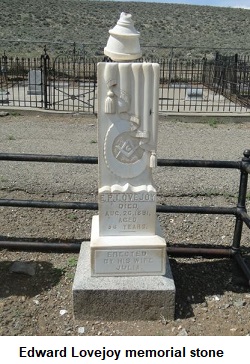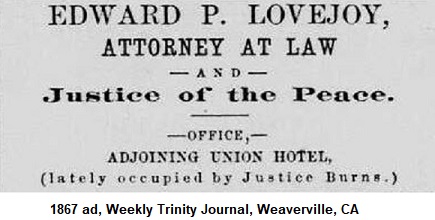Edward Payson Lovejoy (1836-1891)
Son of Rev. Elijah Parish Lovejoy, the Martyr of Freedom
Attorney, Judge, Newspaper Editor, Laborer, Postmaster
Edward Payson Lovejoy was born in St. Louis, Missouri, on March
12, 1836. He was the son of Rev. Elijah Parish Lovejoy (1802-1837)
and Celia Ann French Lovejoy (1813-1870). His father was a native of
Albion, Maine, and his mother was a native of Salisbury, Vermont.
Edward’s Parents
Edward’s father, Elijah Parish Lovejoy, was born in 1802 on his

Edward’s mother, Celia French, was living in St. Charles, Missouri
with her parents when she met Elijah Lovejoy. Her father was an
attorney, and led a comfortable life with his family. Celia’s
uncles, the MIllingtons, were prominent citizens in St. Charles.
Eliah and Celia married on March 4, 1835 in St. Charles, and by June
1835, Celia was pregnant with Edward. Elijah described Celia in a
letter as “tall, well-shaped, fair complexion, dark hair, large blue
eyes, beautiful, intelligent, refined, and of agreeable manners.”
Elijah Lovejoy, before fleeing from St. Louis, spent half his time
in St. Louis working on his paper, The St. Louis Observer, and half
his time “in the country,” preaching in churches. The pregnancy was
taking a toll on Celia’s health, and she stayed with her mother in
St. Charles. She gave birth to Edward on March 12, 1836.
The Lovejoys in Alton
After fleeing to Alton, Illinois, the Lovejoy family set up
housekeeping in a small home on Cherry Street. Eliah set up his
printing office on West Broadway, near Piasa Street. On one
occasion, Elijah took Celia and Edward to St. Charles to stay with
her mother. While there, Edward became ill. The house was visited by
a group of pro-slavery men, wanting Elijah to come outside. Celia
met them at the door and blocked their way, saying they would have
to get through her first. One of the men drew a knife on her, and
she slapped him in the face, and rushed to Elijah, throwing her arms
around him. The men withdrew. Celia fainted, and regaining
consciousness, she relapsed into hysterical fits, moaning and
shrieking. Later, some of the men returned, coming into the house
and to Celia’s bedside, in an effort to force Elijah from the house.
He escaped. The next morning, Celia, exhausted and unfit to leave
her bed, nonetheless joined Elijah and returned home with Edward.
She lived in constant fear of pursuit.
In Alton, Elijah continued to write his anti-slavery views in his
Alton Observer. Several of his printing presses were smashed and
thrown into the street or the river by a mob. Many in the community
tried to dissuade him from writing on the subject of slavery, but he
believed in the freedom of the press and the freedom of all people.
On November 7, 1837, with a new printing press in the Godfrey –
Gilman warehouse in Alton, Elijah and his closest allies (60 men)
waited all day for troubles. When nothing happened, 40 of the men
went home in the evening, leaving Elijah and twenty defenders to
guard the press. That night, Elijah was murdered when he stepped
outside the warehouse, and two of his friends were badly injured.
The press was taken out, and broken up, and thrown into the river.
Celia and Edward Lovejoy had gone to Upper Alton for safety on the
day of her husband’s murder. When told of her husband’s death, she
sank down senseless, trembling as though an arrow had pierced her
heart. Too ill to attend the funeral, she later visited her
husband’s grave, weeping openly, and then went to her mother’s home
in St. Charles. On March 9, 1838, Celia, who had been expecting
another child, delivered a daughter. Within a year, her daughter had
died. Celia and Edward continued living in Alton for a time. At the
time of his father’s death, Edward was twenty months old.
Celia and Edward’s New Life
In time, Celia and Edward Lovejoy moved away from Alton. She
returned briefly in the mid to late 1840s. It was reported in the
Alton Telegraph that Celia married Royal Weller, who operated a
jobbing business in Alton with partner Reuben Gerry. They sold dry
goods, groceries, crockery, boots, shoes, and books. Weller had
stood with Elijah Lovejoy the night of his murder, and was wounded
by gunshot. Royal, Celia, and Edward moved away from Alton. On May
6, 1847, records show that Weller was named guardian for Edward.
Sometime after this, Weller returned to Alton alone. He was judged
insane because of religious fanaticism, and was placed in the
Jacksonville, Illinois, asylum. He died there July 28, 1859, and was
buried near the asylum.
Celia and Edward On Their Own
Celia dedicated the rest of her life to raising her son, Edward.
They moved from place to place, enduring poverty, homelessness,
illness, and alienation from her own family. Her life had been
filled with tragedy and sadness, but Edward was the bright spot and
joy in her life. She loved him dearly, and was entirely devoted to
him.
Edward was educated, and grew into manhood. He and his mother were
very close, and relied upon each other. In 1856, at the age of
twenty, Edward went west to rescue a neighbor’s daughter and son,
who was taken to California by her husband, a gambler. Edward
settled 200 miles north of San Francisco, and sent for Celia to join
him. He became interested in gold
The Death of Celia Lovejoy
Edward’s mother, Celia Lovejoy, died on July 11, 1870. She was 56
years of age. She had been in frail health for many years. A few
days before her death, she attended a dying woman, and from the
shock of witnessing a death-bed scene, she never recovered. A few
days later, she vomited, bursting a blood vessel, and expired in the
arms of her only son, Edward.
The Life of Edward Payson Lovejoy
Edward married Julia Holland after the death of his mother, but
Celia’s death had devastated him. Not long after her death, Julia
Lovejoy lost their son during childbirth. Unhappy with his
surroundings, Edward sold his belongings and moved to Virginia City,
Nevada, in 1877. He started a hotel by 1880, but the census records
list him as a laborer for the Carson and Colorado Railroad, where he
was soon placed in charge of the work gang. In 1881, he moved to
Wabuska, Nevada, and became the Wabuska C. & C. Railroad agent. He
also started his own business, “E. P. Lovejoy, General Merchandise
and Produce,” and was appointed postmaster.
The Death of Edward Payson Lovejoy
Edward Payson Lovejoy died August 26, 1891, in Wabuska, Lyon County,
Nevada. He was 55 years old. He had been ill five or six days, with
difficulties of the heart and stomach. He probably died of heart
failure. He had been a member of the Masonic Lodge, the Odd Fellow
Lodge, and the Ancient Order of United Workmen. He was buried in the
Dayton Cemetery, in Dayton, Nevada. A commemoration was later held
at his grave, and featured a keynote address by U.S. Senator Paul
Simon of Illinois.
Copyright 2023; Beverly Bauser